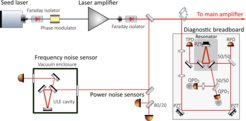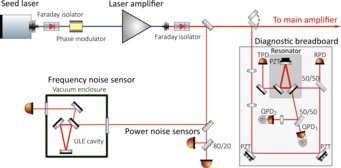Evaluating laser systems for future gravitational-wave detectors
Next-generation detectors will use lasers at longer wavelengths. Which currently available laser systems could serve as prototypes?
The current design of future gravitational-wave detectors such as the Einstein Telescope call for the use of high-power stabilized lasers at a wavelenght of 1550 nm with extremely low noise. AEI researchers have made detailed measurements of several different commercially available seed lasers, laser pre-amplifiers, and laser power amplifiers as possible subcomponents of such laser systems. They independently characterized the frequency noise and power noise of these laser sources. Their research – limited, for technical reasons, to lower laser power – is one more important step towards developing and optimizing the ultra-stable high-power laser systems which could be the heart of future instruments.
Paper abstract

The continuous improvement of current gravitational wave detectors (GWDs) and the preparations for next generation GWDs place high demands on their stabilized laser sources. Some of the laser sources need to operate at laser wavelengths between 1.5 μm and 2.2 μm to support future detectors based on cooled silicon test masses for thermal noise reduction. We present detailed characterizations of different commercial low power seed laser sources and power amplifiers at the wavelength of 1550 nm with respect to performance parameters needed in GWDs. A combination with the most complete set of actuators was arranged as a master-oscillator power amplifier (MOPA), integrated into a stabilization environment and characterized. We present the results of this characterization that make this stabilized MOPA a highly relevant prototype for future GWDs as well as a low noise light source for other experiments in high precision metrology.












